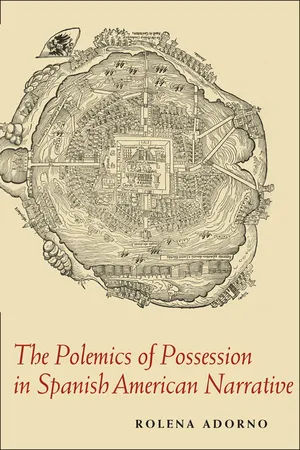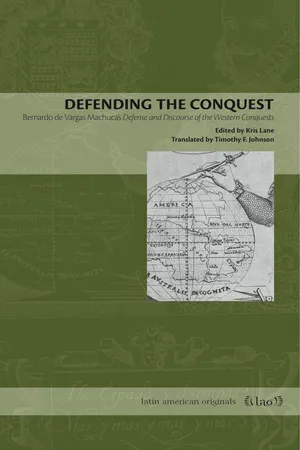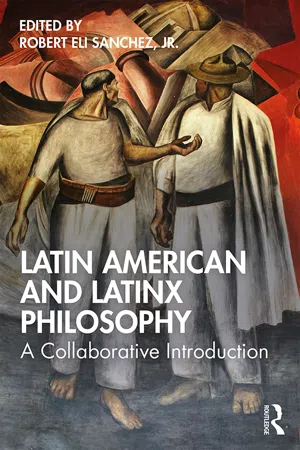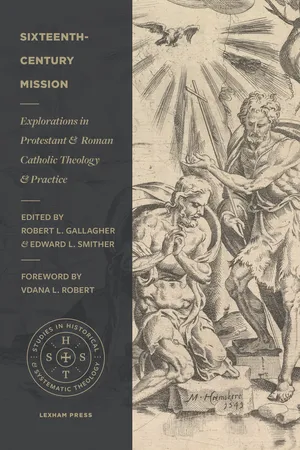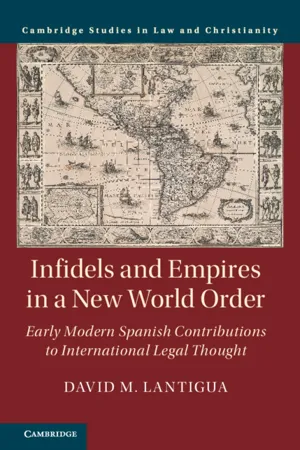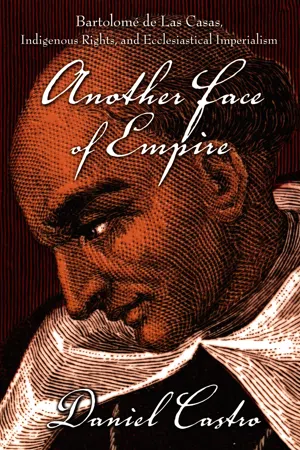History
Valladolid Debate
The Valladolid Debate was a 16th-century discussion held in Spain to address the treatment of indigenous peoples in the Americas. Led by Bartolomé de las Casas and Juan Ginés de Sepúlveda, the debate centered on whether indigenous people had souls and the implications for their treatment. It reflected the moral and ethical dilemmas arising from European colonization and the impact on native populations.
Written by Perlego with AI-assistance
Related key terms
1 of 5
6 Key excerpts on "Valladolid Debate"
- Rolena Adorno(Author)
- 2008(Publication Date)
- Yale University Press(Publisher)
82 bartolomé de las casas bered not only by Spain and Latin America, but also by Anglo– and Latino–North America as well. the great debate in valladolid (1550–1551) Convened by the emperor Charles V, the Valladolid Debate likewise turned on the question of governance, specifically in relation to Christian indoc-trination (see Abril-Castelló). In advance of the debate, the emperor had, by secret instructions to President Pedro de la Gasca in Peru and to the viceroy Antonio de Mendoza in New Spain on April 16 and April 24, 1550, respectively, ordered the suspension of all conquests. Such instructions had been requested by the Council of the Indies on July 3, 1549, and had been the major impetus for the Valladolid Debate. The councilors had requested that the emperor convene learned men, theologians, and jurists to gather with others to consider and decide upon the manner in which conquests should be carried out, so that they could be made justly and with the certainty of conscience, and that a formal instruction should be (subsequently) issued for that purpose. ∂∂ On July 7, 1550, royal letters were sent to the fifteen potential mem-bers of the junta who were to judge the merits of the arguments presented for the purpose of setting or modifying royal policy accordingly. The invitees included seven members of the Council of the Indies; four theo-logians, three of whom were Dominicans (Fray Domingo de Soto, Fray Melchor Cano, and Fray Bartolomé Carranza de Miranda) and the other a Franciscan, Fray Bernardino de Arévalo; two councilors of the Council of Castile (Licenciado Mercado and Dr. Ayala); Licenciado Pedrosa, of the council of religious orders (Consejo de las Órdenes); and the bishop of Ciudad Rodrigo, Pedro Ponce de León. Arévalo was ill, so ultimately the tribunal consisted of fourteen members. ∂∑ The meeting was convened on August 15, 1550. This session lasted about a month; the second session, after numerous delays, was convened in mid-April 1551.- eBook - PDF
Defending the Conquest
Bernardo de Vargas Machuca's Defense and Discourse of the Western Conquests
- Kris Lane, d F. Johnson, Timothy F. Johnson(Authors)
- 2010(Publication Date)
- Penn State University Press(Publisher)
12 The point of Valladolid, as Rolena Adorno has argued, was defining “just war,” Aristotle’s other pretext for enslavement, not debating indigenous humanity. The debate was inconclusive in that no formal winner was declared, but Charles V was persuaded to suspend new conquest petitions briefly. Conquistador rebellions had, however, begun to erode Las Casas’s influence at court by 1551, and perhaps it 10. Daniel Castro, Another Face of Empire: Bartolomé de las Casas, Indigenous Rights, and Ecclesiastical Imperialism (Durham: Duke University Press, 2007). Castro echoes an earlier and much fiercer detractor, the Spanish historian José Pérez de Barra- das, whose 1948 book Los mestizos de América cited Vargas Machuca as an authorita- tive source. 11. Ángel Losada broke down Sepúlveda’s key arguments in his essay, “The Con- troversy Between Sepúlveda and Las Casas in the Junta of Valladolid,” in Friede and Keen, Bartolomé de las Casas in History, 279–306. 12. For early Spanish discussion of Aristotle’s natural slavery theory, including a near-verbatim application of it to native Americans ca. 1600, see Anthony Pagden, The Fall of Natural Man: The American Indian and the Origins of Comparative Ethnology (New York: Cambridge University Press, 1982), 44–47. Map 1 Sixteenth-century Spanish America (Stuart E. Hamilton) 12 | DEFENDING THE CONQUEST was for this reason that he addressed the 1552 Brevísima relación to the future Philip II while he was still a young prince, with the request that he plead the Amerindians’ case before his father, Charles V. As Rolena Adorno has demonstrated, not long before his death in 1566 Las Casas grew even more radical in his critique of the Span- ish enterprise in the Indies. By 1562 he was openly arguing that the whole colonial project was unjustifiable and a grave mistake. - eBook - ePub
Latin American and Latinx Philosophy
A Collaborative Introduction
- Robert Eli Sanchez, Jr.(Authors)
- 2019(Publication Date)
- Routledge(Publisher)
2 “The Indian Problem”Conquest and the Valladolid Debate
Alejandro SantanaIntroduction
“The Indian Problem” generally refers to a complex set of related questions that Europeans, mostly Spaniards, raised about their treatment of the indigenous peoples of the Americas (whom I will refer to as Amerindians). Understanding how this set of questions first emerged in Latin America requires some historical context, as does the Spanish controversy about them. This controversy was on full display during 1550–1551, when a debate was held in Valladolid, Spain. There, Juan Ginés de Sepúlveda and Bartolomé de las Casas debated how best to address this “problem.” In this chapter, I will briefly sketch the historical context that gave rise to the main questions of “The Indian Problem.” I will then outline how some problematic answers to these questions have their roots in Aristotelian philosophy. Next, I will outline the positions advanced by Sepúlveda and Las Casas at Valladolid, and then briefly sketch the contemporary relevance of both “The Indian Problem” and the context from which it emerged.The Emergence of “The Indian Problem” during the Spanish Conquest
Beginning in 1492, Amerindians of the Western hemisphere were confronted by European explorers, mostly Spaniards, arriving on the coasts of their home lands. These explorers were ostensibly looking for new oceanic trade routes to India, but they were also looking for glory, fortune, or both. The Spanish, for their part, encountered diverse peoples and cultures inhabiting a land abundant with material wealth and natural resources.These initial encounters were soon followed by acts of extreme violence, cruelty, and exploitation, with the Amerindians suffering at the hands of Spanish conquistadors. Dominican friar Bartolomé de las Casas tells of numerous atrocities, many of which he witnessed first-hand. He tells of Spaniards hacking innocent Amerindians to pieces: - eBook - ePub
Sixteenth-Century Mission (Studies in Historical and Systematic Theology)
Explorations in Protestant and Roman Catholic Theology and Practice
- Robert L. Gallagher, Edward L. Smither(Authors)
- 2021(Publication Date)
- Lexham Press(Publisher)
This famous debate occurred in August 1550 in Valladolid, Spain. Sepúlveda was not actually arguing for slavery (very few were so bald-faced) but for a paternalism based on the “childlike” qualities of the Indians who needed Spanish guidance to flourish, and in fact needed conversion (utilizing just war theory to support their reasoning). He stated that the Indians “are as inferior to the Spaniards as children are to adults, women are to men, the savage and ferocious to the gentle, the grossly intemperate to the continent and the temperate and finally, I shall say, [are] almost as monkeys are to men.” 28 Las Casas pushed back using a justice argument as well, but contending that the Indians were actually the just ones, having to defend their lives and their lands from invading Spaniards. In addition, while the Spaniards did have just cause in fighting against atrocities such as cannibalism or human sacrifice, the collateral damage of innocent Indian lives lost was so great that it was not worth it. Finally, he also excused their initial resistance to conversion, claiming that they had an “invincible ignorance.” 29 Their arguments consisted of Aristotelian vs. biblical principles. Sepúlveda, as a humanist, employed the Greek philosopher to justify his hierarchical perspective, that some were “natural slaves” and others were “natural masters.” 30 Las Casas used the imago Dei as found in the Bible to lend dignity to the Indians as equally valuable as the Europeans. Both argued for Spain to have some measure of responsibility over the Indians, but for Las Casas it was limited to evangelistic efforts, whereas for Sepúlveda it justified a feudalistic system. Although neither man definitively “won” the debate, history does lean toward Las Casas’s perspective as having had the greater influence. 31 In addition to this debate, Las Casas’s publication of A Short Account of the Destruction of the Indies in 1552 really helped to shed light on the subject - eBook - PDF
Infidels and Empires in a New World Order
Early Modern Spanish Contributions to International Legal Thought
- David M. Lantigua(Author)
- 2020(Publication Date)
- Cambridge University Press(Publisher)
Las Casas, in sharp contrast, deployed natural law and the law of nations in a critical mode to explicate native political resistance toward Spanish aggression. For the Dominican friar, these universal laws were expressions of human reason present among diverse peoples but also potent sources for safeguarding subjective rights. The junta at Valladolid was a defining moment in the history of Christian– infidel relations, and therefore international legal thought in the West. It did not establish a transatlantic treaty between different peoples, neither did it construct a mutually agreed upon arrangement of laws and institutions bind- ing Europeans and non-Europeans. Nevertheless, amidst an intercontinental crisis of conscience culminating at the junta, Spanish theologians generated an inclusive, flexible, and reflexive regime of law based on common humanity and universal society to morally recognize the worth, and juridically protect the rights, of non-European individuals and peoples confronted with European colonialism. As we observed in the previous chapter, this crucible of conflict in the New World did not yield a formal or a conventional system establishing international law. Rather, what emerged was an enduring norma- tive commitment to the idea and practice of world order with legal ramifica- tions for protecting the subjective rights of non-European unbelievers from foreign and domestic tyranny. The Spanish contributions to international legal thought become more conspicuous in the context of the Valladolid junta, which retained an ambivalent legacy for early modern and modern discussions of European colonialism considered in the next chapter. bishop las casas and the valladolid junta Educated in theology, philosophy and letters at Alcala ´ and Bologna, respec- tively, Juan Gine ´s de Sepu ´ lveda (1490–1573) imbibed a brand of humanism that attempted to retrieve a classical warrior ethic of Roman glory similar to Machiavelli and in contrast to Erasmianism. - eBook - PDF
Another Face of Empire
Bartolomé de Las Casas, Indigenous Rights, and Ecclesiastical Imperialism
- Daniel Castro, Walter D. Mignolo, Irene Silverblatt, Sonia Saldívar-Hull, Walter D. Mignolo, Irene Silverblatt, Sonia Saldívar-Hull(Authors)
- 2007(Publication Date)
- Duke University Press Books(Publisher)
was justified in terms of the expectations that it would fulfill its duty as a Chris-tian nation to disseminate the true faith and to assume the tutelage of the infidels while taking over their temporal possessions. Significantly, after Valladolid the question of whether Spain had the right to have dominion over the New World was never raised again. In the aftermath of the debate against Sepúlveda, royal authority was further reaffirmed with the emergence of the issue of perpetuity pitting the encomenderos against the reformers and the Peruvian Indian elite. By ac-cepting the king’s absolute authority on all matters pertaining to the Indies, Las Casas’s intervention in the debates about perpetuity, like his participa-tion in Valladolid, helped in no small way to consolidate the power of the imperial center and the values that it represented in the New World.
Index pages curate the most relevant extracts from our library of academic textbooks. They’ve been created using an in-house natural language model (NLM), each adding context and meaning to key research topics.
